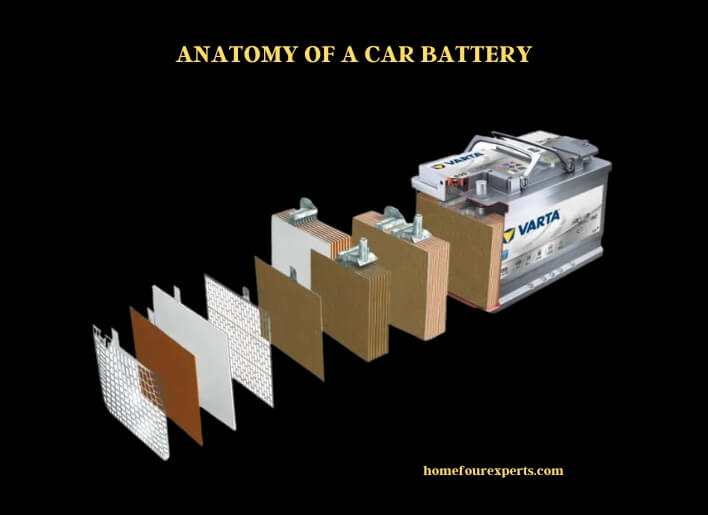Published on: June 12, 2022
Written by Liam Jaxon / Fact-checked by David Rowan
Powering a ride on your car can be complex if you don’t understand the basic components of a battery. Without knowing the electrical system, you can get stuck driving.
A battery can provide the zap of electricity that is essential to work all electrical components. It also works to transfer chemical energy into the power energy. Using this power your car engine will run and establish the perfect voltage.

Do you understand in detail how the battery powers your engine? Or, how can it work?
Follow this article. In this brief writing, we explain this simply.
Anatomy of a Car Battery
A car battery is constructed using several elements such as battery acid, battery terminal, negative plate, cast-on strap for batteries, battery positive plate, battery separator, and more.
Battery Acid
The acid of a battery is a high virtue treatment of water and sulfuric acid.
Battery Terminal or Bushing
Battery busing or terminals are the exact point of the battery and your car’s electrical system. These are related to the positive strap along with the negative strap of the end cells.
Cast-on Strap for Batteries
The cast-on straps are connected to the lid of each element. They provide a good electrical relation to the bushing or terminals.
Battery Positive Plate
With lead dioxide active & a metal grid, the positive battery plate is constructed.
Battery Negative Plate
Battery negative plate includes a metal grid that is spongy lead active material.
Battery Separator
The battery separator is one of polyethylene materials. It lends a worthwhile flow of electrical current by separating the positive plates from the negative plates.
Lid on Battery
The lid contains polypropylene resin and is locked to the battery case.
Battery Case
The case is also put together with polypropylene resin. It is designed to hold the battery plates, electrolyte, and cast-on straps. This battery case can decrease vibration and increase the battery life.
Battery Plates
The battery plates are the combination of positive and negative plates. These involve at the top of the cast-on strap and connect to the positive and negative plates.
Battery Paste
With the mixture of the lead oxide, the battery paste is made. This is able to create not only lead dioxide but sponge lead. Connect with the negative and positive battery.
How Does a Car Battery Work?
Before jumping into how a car battery works, let’s look at the car batteries general info. According to the folks at NASA, a battery is “a device that translates chemical energy into electricity.” Batteries are the mixture of some cells. These cells contain genuine energy. This chemical energy transfers to electrical energy.
Now turning on the main point. Maximum car batteries work that means moving & grooving on a lead-acid chemical reaction. The batteries stand in the SLI category. SLI means starting, lighting, and ignition. This gives short flares of energy that helps to empower the car’s light, engine, and accessories.
After using it for a long time, the battery power can decrease so the engine doesn’t get enough power to run. In this case, the alternator supports moving.
However, the most common SLI batteries have six cells. Every cell has two plates or grids. One is designed to use lead dioxide and the other of lead. Each cell can produce around 2 volts of energy. You may have six cells that means a 12- volt car battery. Some batteries are 12.4 volts or more.
Just because of dipped in the sulfuric acid, it can happen between the two plates. According to the scientific era, the acid decrees as a catalyst. Plus, accelerate a reaction on the lead dioxide plate that causes the plate to produce two things like lead sulfate and ions.
While adjacent plates produce lead sulfate and hydrogen and the ions produced by the lead dioxide plate react. Chemical reaction generates electrons. And these electrons gangs produce electricity around the plates. An excellent thing happens when electricity arises out of your car battery terminals. Then, turn on your engine along with the headlights. You can play it on the radio if you want.
Don’t forget to continue charging your battery. If you don’t charge, this chemical reaction can stop entirely reversibly. For the duration of full battery life, you must charge it properly. If you charge it the wrong way, it can boil. Batter to visit this post.
This lead and lead dioxide organize on the battery plates while you are applying current at just the right voltage. The unique thing, it is possible to reuse the battery again and again.
Can you leave the battery fully discharged for too long?
No, if you leave it, it goes into a dead condition. And, enable it to reverse the chemical reaction. That is why you need to replace the battery.
Frequently Asked Questions
Can Using Hazard Lights Drain the Car Battery and Affect Its Functioning?
Using hazard lights and battery drain can be a common concern among drivers. While using hazard lights for a short period is unlikely to affect the battery, prolonged use can lead to drain. It’s important to only use hazard lights when necessary to avoid any impact on the car’s functioning.
Can the Anatomy of a Car Battery Help me Understand Marine Batteries in a Boat?
Understanding the anatomy of a car battery can provide valuable insights into a marine battery setup for a boat. Both types of batteries share similarities in terms of lead plates, electrolyte solution, and terminal connections. However, marine battery setup requires additional features to withstand the unique demands of the marine environment.
What Are the Components of a Car Battery?
Generally, a car battery or an automobile battery contains six cells that means six or less the six components. Each cell stores a sulfuric acid.
The three basic components of the battery are two terminals and anode & cathode. Most of the terminals formulated from several chemicals like metals.
Electrolyte, a chemical flowing, works to separate these terminals. It also aids inflowing the electrical charge from the cathode to the anode.
How Many Plates Does a Car Battery Have?
A battery has two lead plates, one is a positive plate and the other is a negative plate. These plates are attached to the top of a cast-on strap. Positive plate made of lead dioxide and negative contains sponge lead.
Conclusion
So, most common car batteries have several components like battery terminal, acid, plates, and more. We have already talked about this matter and how batteries work although it is a pretty huge responsibility to discover.
A battery produces a bunch of electricity that is indispensable to all the electrical ingredients in your vehicle. Without battery power, the car won’t start, you have possibly noticed.
About This Writer

Hi, I am responsible for the 'Homeowners Power Solutions' category. My name is Liam Jaxon and a licensed technician with 7 years of experience in vehicle batteries, electrical gadgets, and home appliances. My working experience in different residential & light commercial electrical sectors and the automobile industry helped to acquire vast knowledge in this industry.